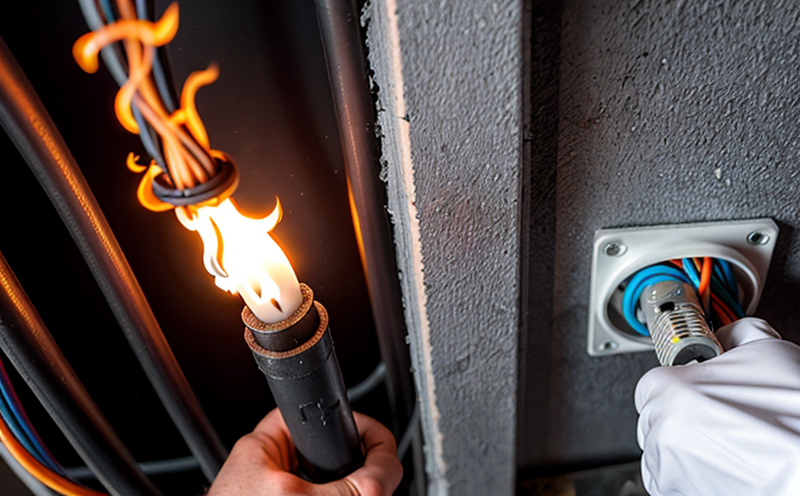Smoke Density and Toxic Gas Measurement During Cable Fires
The ability to measure smoke density and toxic gas levels during cable fires is critical in ensuring fire safety compliance. This test evaluates how effectively cables can resist combustion, preventing the release of harmful gases such as carbon monoxide (CO) and hydrogen cyanide (HCN), which are known to be lethal in high concentrations. The objective is to ensure that the materials used in electrical installations do not contribute significantly to the spread or intensity of a fire.
During cable fires, smoke density and toxic gas production can vary widely depending on factors such as the type of insulation, the fuel load, and environmental conditions. Smoke density is measured using optical sensors capable of detecting particulate matter, while toxic gases are quantified through gas chromatography or infrared detection techniques. These measurements provide a comprehensive understanding of the fire’s behavior and help identify potential risks in building design and material selection.
The test setup typically involves placing the cable under controlled conditions that simulate real-world scenarios, such as overheating due to excessive current or mechanical damage. Specimen preparation is crucial; this includes selecting appropriate lengths of cable that are representative of typical installations while ensuring they meet the required dimensions for testing. The apparatus used in these tests often consists of a combustion chamber where the cable can be ignited and its performance observed.
The acceptance criteria for this test emphasize the importance of minimizing smoke emission levels and reducing toxic gas concentrations to safe limits. Compliance with international standards like ISO 1363-2 or ASTM E729 ensures that results are consistent across different laboratories, providing reliable data for regulatory approval processes.
Understanding the specifics of this testing method can help stakeholders make informed decisions about fire safety measures. For instance, manufacturers can use these findings to improve product designs and enhance overall performance. Regulatory bodies gain valuable insights into potential hazards associated with specific types of cables, enabling them to set stricter guidelines if necessary.
Applied Standards
Cables & Wiring Fire Resistance Testing adheres strictly to several international standards that govern the measurement of smoke density and toxic gas production during cable fires. These include:
- ISO 1363-2: This standard specifies methods for determining the fire resistance properties of materials, including the generation of smoke and noxious gases.
- ASTM E729: Provides procedures for measuring smoke obscuration in flame spread tests on building products.
- EN 50398: Focuses on the classification of cables according to their performance under fire conditions.
The adherence to these standards ensures consistent and accurate results, which are essential for meeting regulatory requirements and gaining industry recognition. Compliance with such rigorous testing protocols demonstrates a commitment to excellence in product development and quality assurance.
Industry Applications
| Application Area | Description |
|---|---|
| Data Centers | In data centers, where continuous operation is paramount, ensuring that cables do not contribute to smoke or toxic gas emissions during a fire can prevent downtime and protect personnel. |
| Hospitals | Given the sensitive nature of patient care in hospitals, minimizing smoke and toxic gas production from electrical installations ensures safety for both staff and patients. |
| Residential Buildings | In residential settings, reducing fire risks associated with cable failures helps protect occupants' lives and properties. |
| Offshore Platforms | Due to the remote locations of offshore platforms, any fire incident could lead to significant loss. Thus, ensuring proper fire resistance is crucial here. |
The measurement of smoke density and toxic gas during cable fires plays a vital role in enhancing safety across various industries by providing critical data that informs decision-making processes related to material selection, installation practices, and operational procedures.
Why Choose This Test
- Comprehensive Evaluation: Measures both smoke density and toxic gas production simultaneously, offering a holistic view of the fire behavior.
- Regulatory Compliance: Ensures adherence to international standards, facilitating easier compliance with local regulations.
- Enhanced Safety: Provides valuable information that can be used to improve product designs and installation methods, thereby enhancing overall safety.
- Predictive Insight: Offers predictive insights into potential risks associated with specific types of cables, allowing for proactive measures to mitigate these risks.
- Cost-Effective Solutions: By identifying problematic areas early on, this test helps avoid costly recalls or redesigns later in the product lifecycle.
- Detailed Reporting: Generates detailed reports that can be used by various stakeholders, including manufacturers, regulatory bodies, and end-users.
The comprehensive nature of smoke density and toxic gas measurement during cable fires makes it an indispensable tool for ensuring fire safety. It not only meets current standards but also anticipates future challenges in the field of electrical engineering and materials science.





